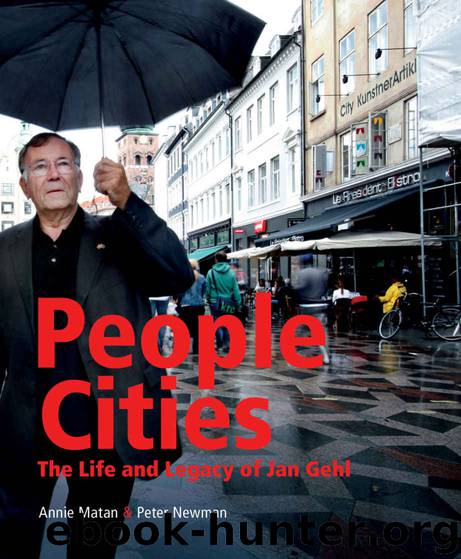People Cities: The Life and Legacy of Jan Gehl by Matan Annie & Newman Peter

Author:Matan, Annie & Newman, Peter [Matan, Annie]
Language: eng
Format: epub
Publisher: Island Press
Published: 2016-11-14T16:00:00+00:00
PUBLIC SPACE PUBLIC LIFE – COPENHAGEN, 1996
Jan Gehl & Lars Gemzøe
In 1996, the City of Copenhagen was selected as the European Capital of Culture by the European Union. Just as was done in the many previous “capitals,” the local institutions contemplated how they could contribute to this celebration. In the School of Architecture, it was decided that they would strengthen the already existing collaboration between the School of Architecture and the City by having the city life researchers from the urban design department carry out another, and considerably enlarged, Public Space Public Life study. This is how the study and book Public Spaces Public Life, Copenhagen 1996 came about. The school of architecture, the City of Copenhagen, the business community of central Copenhagen, and various foundations all contributed to cover the costs. The studies were carried out during 1995, in order to be ready for 1996.
The study and the book are organized in three parts. Part one is an overview of the spaces available in the city, presenting the history of how the car-free public spaces within the city had developed since 1962. The city center in 1996 is described—residences, educational institutions, night life, safety, traffic, parking, bicycling, and many other items related to the present state of the city. The second part of the book presents the current use of the city through summer and winter, on the main streets and on the side streets, during events and ordinary days as well as the impact of street vendors and performers and the rapid growth in the café culture. While the observation methods used were originally developed for the studies recorded in Life Between Buildings, the third part of the book introduces a new study tool: the interview. Not having previous experience in this technique, Jan and Lars asked professor David Yencken from the University of Melbourne to join the team and organize the interviews. These interviews cast valuable light on a number of questions that the observations alone could not answer: Who were the city users? Where did they come from? How did they travel to and from the city? What were their motives for coming? What did they like and dislike about the city? This was seen as a most valuable expansion of the traditional counting and observation studies.
A characteristic of this book is the presentation of maps, plans, and graphics that tell the story of the city, how the users of the public spaces conduct their public lives, and how study methodologies were applied. In Copenhagen, the book was celebrated as an illustration of how the city had developed. An English-language version was produced by the Danish Architectural Press. Though the book is about Copenhagen, this English-language version had a much larger distribution than the Danish version. Ten years after the last Danish book was printed and sold, the English version was still being published and sold, emphasizing a great interest particularly in the methodologies used and the results achieved well beyond Copenhagen.
Development of car-free streets aim
Download
This site does not store any files on its server. We only index and link to content provided by other sites. Please contact the content providers to delete copyright contents if any and email us, we'll remove relevant links or contents immediately.
Kathy Andrews Collection by Kathy Andrews(11730)
The remains of the day by Kazuo Ishiguro(8823)
Paper Towns by Green John(5091)
Spare by Prince Harry The Duke of Sussex(5072)
Industrial Automation from Scratch: A hands-on guide to using sensors, actuators, PLCs, HMIs, and SCADA to automate industrial processes by Olushola Akande(4983)
The Body: A Guide for Occupants by Bill Bryson(4974)
Machine Learning at Scale with H2O by Gregory Keys | David Whiting(4183)
Be in a Treehouse by Pete Nelson(3948)
Never by Ken Follett(3793)
Harry Potter and the Goblet Of Fire by J.K. Rowling(3775)
Goodbye Paradise(3728)
Into Thin Air by Jon Krakauer(3313)
The Remains of the Day by Kazuo Ishiguro(3293)
The Cellar by Natasha Preston(3262)
The Genius of Japanese Carpentry by Azby Brown(3226)
Fairy Tale by Stephen King(3220)
120 Days of Sodom by Marquis de Sade(3182)
The Man Who Died Twice by Richard Osman(2997)
Drawing Shortcuts: Developing Quick Drawing Skills Using Today's Technology by Leggitt Jim(2996)
